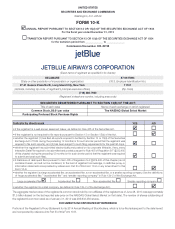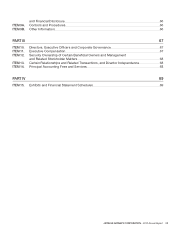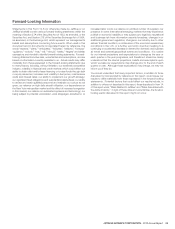JetBlue Airlines 2013 Annual Report Download - page 16
Download and view the complete annual report
Please find page 16 of the 2013 JetBlue Airlines annual report below. You can navigate through the pages in the report by either clicking on the pages listed below, or by using the keyword search tool below to find specific information within the annual report.
JETBLUE AIRWAYS CORPORATION-2013Annual Report10
PART I
ITEM 1Business
Fleet Structure
We currently operate the Airbus A321, the Airbus A320 and the EMBRAER
190 aircraft types. In 2013 our fleet had an average age of 7.1 years and
operated an average of 11.9 hours per day. By operating a younger fleet
as well as scheduling and operating our aircraft more efficiently we are able
to spread related fixed costs over a greater number of available seat miles.
The reliability of our fleet is essential to our operations running smoothly.
We are continually working with our aircraft and engine manufacturers to
enhance our efficiency performance. In 2015 we expect to start retrofitting
our Airbus aircraft with Sharklets
®
, a blended wingtip devices designed
to improve the aircraft’s aerodynamics, which we anticipate will result
in improved range and flight performance in addition to fuel savings.
We are working with the FAA in efforts towards implementing the Next
Generation Air Transportation System, or NextGen by 2020. In 2012 we
equipped 35 of our Airbus A320 aircraft to test ADS-B Out, a satellite
based technology aimed to facilitate the communication between pilots
and air traffic controllers. Even though it is still in the testing phase we have
already seen benefits from the ADS-B Out equipment. This includes being
able to reroute flights over the Gulf of Mexico to avoid bad weather, an
area where the current FAA radar coverage is not complete. This NextGen
technology is expected to improve operational efficiency in the congested
airspaces in which we operate. In 2012 we also became the first FAA
certified Airbus A320 carrier in the U.S. to use satellite-based Special
Required Navigation Performance Authorization Required, or RNP AR,
approaches at two of JFK’s prime and most used runways, 13L and 13R.
Fleet Maintenance
Consistent with our core value of safety, our FAA-approved maintenance
program is administered by our technical operations department. We use
qualified maintenance personnel and ensure they have comprehensive
training. We maintain our aircraft and associated maintenance records in
accordance with, if not exceeding, FAA regulations. Fleet maintenance
work is divided into three categories: line maintenance, heavy maintenance
and component maintenance.
The bulk of our line maintenance is handled by JetBlue technicians and
inspectors. It consists of daily checks, overnight and weekly checks,
“A” checks, diagnostics and routine repairs. Heavy maintenance checks
consist of a series of more complex tasks taking from one to four weeks
to accomplish; these items are typically performed once every 15 months.
All of our aircraft heavy maintenance work is performed by FAA-approved
facilities such as Embraer, Pemco and Timco, subject to direct oversight
by JetBlue personnel. We outsource heavy maintenance as the costs
are lower than if we performed the tasks internally (including inventory
related costs). Component maintenance on equipment such as engines,
auxiliary power units, landing gears, pumps and avionic computers are
all performed by a number of different FAA-approved repair stations. We
have maintenance agreements with MTU Maintenance Hannover GmbH,
MTU, for the engines that power our Airbus fleet and with GE (OEM) for our
EMBRAER 190 aircraft engines. We also have an agreement with Lufthansa
Technik AG for the repair, overhaul, modification and logistics of certain
Airbus components. Many of our maintenance service agreements are
based on a fixed cost per flying hour; these vary based upon the age of
the aircraft and other operating factors impacting the related component.
Required maintenance not otherwise covered by these agreements is
performed on a time and materials basis. All other maintenance activities are
sub-contracted to qualified maintenance, repair and overhaul organizations.
Aircraft Fuel
Aircraft fuel is our largest expense; its price and availability has been extremely volatile in the past due to global economic and geopolitical factors which we
can neither control nor accurately predict. We use a third party fuel management service to procure most of our fuel. Our historical fuel consumption and costs
for the years ended December 31 were:
2013 2012 2011
Gallons consumed (millions) 604 563 525
Total cost (millions)(a) 1,899 1,806 1,664
Average price per gallon(a) $ 3.14 $ 3.21 $ 3.17
Percent of operating expenses 37.9% 39.2% 39.8%
(a) Total cost and average price per gallon each include related fuel taxes as well as effective fuel hedging gains and losses.
We attempt to protect ourselves against the volatility of fuel prices by entering into a variety of hedging instruments. These include swaps and options
with underlyings of jet fuel, crude and heating oil. We also use fixed forward price agreements, or FFPs, which allow us to lock in the price of fuel for
specified quantities and at specified locations in future periods.
























